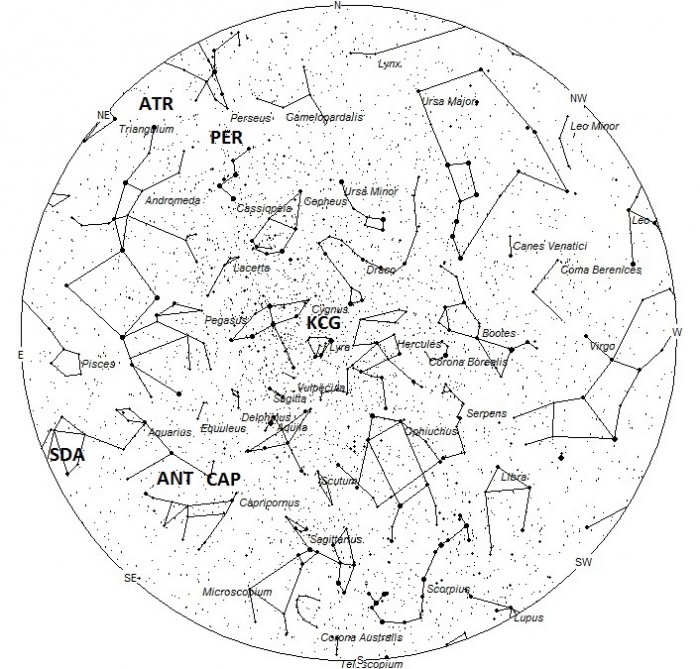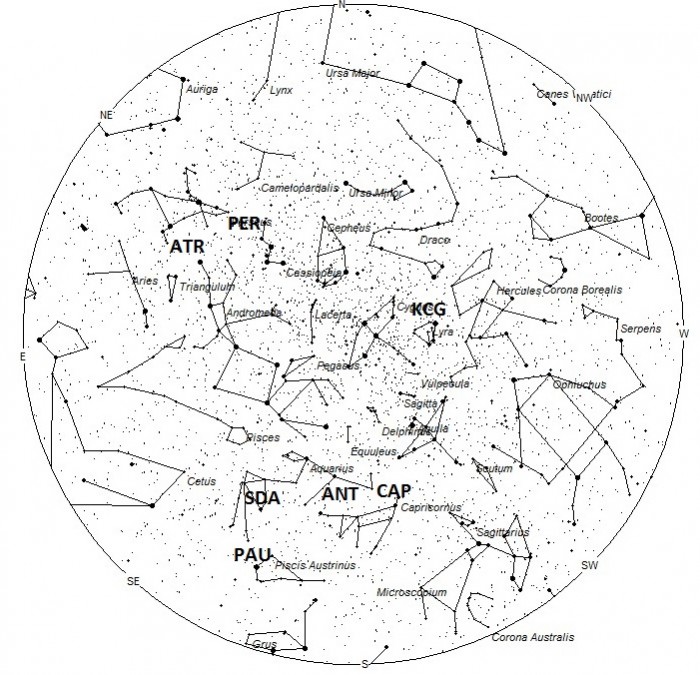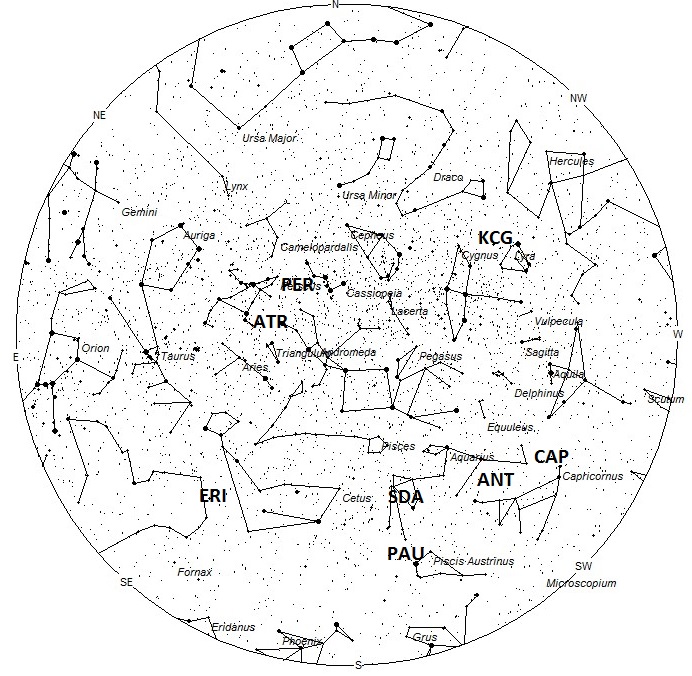Meteor activity kicks into high gear in August as seen from the northern hemisphere. The main reason for all this activity is the Perseid shower that peaks on August 12. This shower is active most of the month and remains above the level of the sporadic background for a week centered on August 12. The sporadic activity is also near maximum as seen from the northern hemisphere and is now more than double the rates from just three months ago. As seen from south of the equator, meteor rates are still decent but falling rapidly. The sporadic rates continue their downward slide and the Perseid radiant does not rise high into the sky as seen in the southern hemisphere so rates from this shower are greatly reduced when compared to the northern hemisphere.
During this period the moon reaches its new phase on Tuesday August 6th. At this time the moon is located near the the sun and will be invisible at night. This weekend the waning crescent moon will not interfere with observing as it is very thin and will only rise just before the start of morning twilight. Toward the end of this period the waxing crescent moon will enter the evening sky but again it will be very thin and will set soon after dusk. The estimated total hourly meteor rates for evening observers this week is near five for observers located in the northern hemisphere and three for those viewing south of the equator. For morning observers the estimated total hourly rates should be near thirty-five as seen from mid-northern latitudes and near thirty for observers viewing from tropical southern latitudes. The actual rates will also depend on factors such as personal light and motion perception, local weather conditions, alertness and experience in watching meteor activity. Note that the hourly rates listed below are estimates as viewed from dark sky sites away from urban light sources. Observers viewing from urban areas will see less activity as only the brightest meteors will be visible from such locations.
The radiant (the area of the sky where meteors appear to shoot from) positions and rates listed below are exact for Saturday night/Sunday morning August 3/4. These positions do not change greatly day to day so the listed coordinates may be used during this entire period. Most star atlases (available at science stores and planetariums) will provide maps with grid lines of the celestial coordinates so that you may find out exactly where these positions are located in the sky. A planisphere or computer planetarium program is also useful in showing the sky at any time of night on any date of the year. Activity from each radiant is best seen when it is positioned highest in the sky, either due north or south along the meridian, depending on your latitude. It must be remembered that meteor activity is rarely seen at the radiant position. Rather they shoot outwards from the radiant so it is best to center your field of view so that the radiant lies at the edge and not the center. Viewing there will allow you to easily trace the path of each meteor back to the radiant (if it is a shower member) or in another direction if it is a sporadic. Meteor activity is not seen from radiants that are located below the horizon. The positions below are listed in a west to east manner in order of right ascension (celestial longitude). The positions listed first are located further west therefore are accessible earlier in the night while those listed further down the list rise later in the night.
The following sources of meteoric activity are expected to be active this week:
The Kappa Cygnids (KCG) are weakly active during this period from a wide radiant located at 18:40 (280) +44. This location lies actually lies in northern Lyra, five degrees north of the brilliant star Vega (Alpha Lyrae). Maximum activity is predicted to occur on August 18th so current rates would be less than one per hour no matter your location. With an entry velocity of 23 km/sec. most of these meteors will appear to travel slower than average. The radiant is best placed near 2300 LDT (11pm LDT) when it lies nearly overhead for much of the Northern Hemisphere. Due to its high northern declination this activity is not well seen from the southern hemisphere. Despite the low rates seen from this source, this shower is known to be a producer of fireball class meteors.
The Alpha Capricornids (CAP) reached maximum activity on July 30 but are still active for another two weeks. The wide radiant is currently located at 20:32 (308) -09. This position lies in northwestern Capricornus, four degrees northeast of the fourth magnitude star double star known as Algiedi (Alpha Capricornii). The radiant is best placed near 0100 Local Daylight Time (LDT), when it lies on the meridian and is highest in the sky. Current rates should be near two per hour as seen from the northern hemisphere and three per hour as seen from south of the equator. Don’t confuse these meteors with the anthelion meteors, which have a radiant just to the east. Both radiants need to be in your field of view to properly sort these meteors. With an entry velocity of 25 km/sec., most activity from this radiant would be slow, a bit slower than the anthelions. This radiant is well seen except for far northern latitudes where it remains twilight all night long and the radiant does not rise as high into their sky.
The center of the large Anthelion (ANT) radiant is currently located at 21:36 (324) -12. This position lies in northeastern Capricornus, seven degrees south of Sadalsuud (Beta Aquarii). Due to the large, oval-shaped radiant, activity from this source may also be seen coming from southeastern Aquila, northwestern Aquarius, Pisces Austrinus, as well as Capricornus. These meteors may be seen all night long but the radiant is best placed near 0200 LDT when it lies on the meridian and is located highest in the sky. Rates at this time should be near two per hour regardless of your location . With an entry velocity of 30 km/sec., the average Anthelion meteor would be of slow velocity.
The Delta Aquariids (SDA) reached maximum activity on July 30th. The radiant is located at 23:04 (346) -15. This position is located in central Aquarius, two degrees northwest of the third magnitude star known as Skat (Delta Aquarii). Hourly rates will depend on your latitude and time of night. The radiant culminates near 0300 LDT. At this time hourly rates should range from fifteen shower members as seen from the mid-southern hemisphere to near five as seen from mid-northern latitudes. With an entry velocity of 42 km/sec., most activity from this radiant would be of average velocities.
The Piscids Austrinids (PAU) are a minor shower not well seen from the northern hemisphere. This radiant is active from July 15 through August 10. Maximum activity occurred on July 28 when the zenith hourly rate (ZHR) may reach five. These rates are only seen from the southern hemisphere where the radiant passes overhead. From mid-northern latitudes, rates of one per hour at maximum are usually seen. The radiant is currently located at 23:12 (348) -29. This position lies in western Sculptor, two degrees northeast of the first magnitude star Fomalhaut (Alpha Pisces Austrini). The radiant is best placed near 0300 LDT, when it lies highest in the sky. With an entry velocity of 35km/sec., most activity from this radiant would be of average velocities.
Activity from the Perseids (PER) is slowly increasing as we approach maximum activity on August 12. The radiant is currently located at 01:40 (035) +55. This position lies in extreme northwestern Perseus. The nearest star of note would be fourth magnitude Theta Cassiopeiae, which lies three degrees west of the radiant. The radiant is best placed during the last hour before the start of morning twilight when it lies highest in a dark sky. Since the maximum is not until August 12th, current rates would be 10-15 per hour for observers situated at mid-northern latitudes and 3-5 per hour as seen from mid-southern latitudes. Activity from this source is not visible south of 40 degrees south latitude. With an entry velocity of 61 km/sec., most activity from this radiant would be swift.
The Eta Eridanids (ERI) are a newly found shower best seen from July 31 through August 17 with maximum activity occurring on August 4th. Weak activity may be seen this week with a radiant located at 02:40 (040) -14. This area of the sky is situated on the Cetus/Eridanus border, close to the spot occupied by the fourth magnitude star Pi Ceti. This area of the sky does not rise until 0200 LDT and is located highest in a dark sky during the last hour before dawn. Rates are expect to be near two per hour no matter your location. With an entry velocity of 66 km/sec., the average Eta Eridanid meteor would be swift.
A new source found by IMO video cameras to be active this time of year are the Alpha Triangulids (ATR). This radiant has recently been found to be active later than previously published, with the activity period ranging from July 25 through August 20 with maximum activity occurring on July 27. Current rates would be near one per hour as seen from the northern hemisphere and less than one from the southern hemisphere. The radiant is currently located at 02:36 (039) +41, which is actually situated in extreme eastern Andromeda, six degrees east of the famous second magnitude star double star Almach (Gamma Andromedae). The radiant is best placed during the last hour before dawn, when it lies highest in a dark sky. With an entry velocity of 68 km/sec., the average Alpha Triangulid meteor would be swift.
As seen from the mid-northern hemisphere (45N) one would expect to see approximately thirteen sporadic meteors per hour during the last hour before dawn as seen from rural observing sites. Evening rates would be near four per hour. As seen from the tropical southern latitudes (25S), morning rates would also be near seven per hour as seen from rural observing sites and two per hour during the evening hours. Locations between these two extremes would see activity between the listed figures.
The table below presents a list of radiants that are expected to be active this week. Rates and positions are exact for Saturday night/Sunday morning unless indicated in the verbal description of each shower.
| SHOWER | DATE OF MAXIMUM ACTIVITY | CELESTIAL POSITION | ENTRY VELOCITY | CULMINATION | HOURLY RATE | CLASS |
| RA (RA in Deg.) DEC | Km/Sec | Local Daylight Time | North-South | |||
| Kappa Cygnids (KCG) | Aug 18 | 18:40 (280) +44 | 23 | 23:00 | <1 – <1 | II |
| Alpha Capricornids (CAP) | Jul 30 | 20:32 (308) -09 | 25 | 01:00 | 1 – 2 | II |
| Anthelions (ANT) | – | 21:36 (324) -12 | 30 | 02:00 | 2 – 2 | II |
| Delta Aquariids (SDA) | Jul 30 | 23:04 (346) -15 | 42 | 03:00 | 5 – 15 | I |
| Pisces Austrinids (PAU) | Jul 28 | 22:48 (342) -31 | 35 | 03:00 | <1 – 1 | II |
| Perseids (PER) | Aug 12 | 01:40 (025) +54 | 61 | 06:00 | 10 – 3 | I |
| Eta Eridanids (ERI) | Aug 04 | 02:12 (033) -15 | 66 | 07:00 | 2 – 2 | IV |
| Alpha Triangulids (ATR) | Jul 27 | 02:16 (034) +41 | 68 | 07:00 | 1 – <1 | IV |
 American Meteor Society
American Meteor Society



We (wife and I ) observed 12-15 meteors last night at 11:15 from our home in Waynesville, NC in a 15 minute period in the east and southeast sky. A couple were big fireballs.
Saw 1 possible Kappa Cygnid at 0210UT on 060813 moving E-W; 2 Perseids in rapid succession at 0723UT on 070813, near Middletown, CT with a limiting magnitude of 5.0. Meteor magnitude estimates: 0.0 for possible Kappa Cygnid (near Vega); 1st Perseid: -1.0. 2nd Perseid: 3.0 (near Capella).